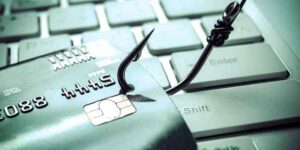In the fight against phishing attacks, cybersecurity professionals often debate the effectiveness of whitelisting versus blacklisting domain names. While both approaches aim to protect users from malicious websites, whitelisting is generally considered a more effective and proactive solution in comparison to blacklisting. Here’s why we have implemented whitelisting in PhishGuard:
1. Blacklisting is Reactive, Not Proactive
Blacklisting involves maintaining a database of known malicious or suspicious domain names. When a user attempts to access a website, the blacklist is checked to ensure that the domain is not flagged. While this method does offer protection, it is reactive—meaning it only works for domains that have already been identified as harmful.
The challenge with blacklisting is that cybercriminals frequently create new domains and phishing websites at an astonishing rate. By the time a domain makes it to a blacklist, the attackers may have already switched to a new, unlisted domain. According to the Anti-Phishing Working Group (APWG), phishing domains are often used for just a few hours or days, which makes it difficult to keep blacklists up-to-date.
2. Whitelisting Ensures Trustworthy Traffic
Whitelisting, on the other hand, is proactive. Instead of blocking access to known malicious domains, it allows access only to a predefined list of trusted websites. This ensures that users can only access verified, safe domains, dramatically reducing the chances of stumbling upon a phishing site.
This approach is particularly effective in enterprise environments where employees typically only need access to a limited number of websites related to their work. By restricting access to pre-approved domains, companies can minimize the risk of employees clicking on phishing links or being redirected to malicious sites.
3. Whitelisting Reduces False Positives
One of the key drawbacks of blacklisting is the potential for false positives. Legitimate websites can sometimes be mistakenly flagged as harmful, disrupting the user experience. This is particularly problematic in industries like e-commerce or financial services, where customers may need to access a wide range of services.
Whitelisting eliminates this issue because only approved domains are accessible. If a website is on the whitelist, it is trusted and will not be accidentally blocked, resulting in fewer interruptions for users and ensuring smoother business operations.
4. Phishing Domains Are Short-Lived
One of the biggest challenges for blacklisting is the short lifespan of phishing domains. Many phishing attacks involve websites that are live for only a few hours or days before they are shut down or moved to a different domain. Cybercriminals can quickly register new domains, making it almost impossible for blacklists to keep up.
According to the Verizon Data Breach Investigations Report, the average lifespan of a phishing website is around 24-48 hours, which is far shorter than the time it takes for most blacklists to update. This gap leaves users vulnerable to phishing attacks in the window between when a domain is registered and when it is blacklisted.
5. Blacklisting Is Resource-Intensive
Maintaining an effective blacklist requires significant resources. Not only must organizations continually update the list as new phishing domains are discovered, but they also need to ensure that legitimate sites are not mistakenly flagged. This requires ongoing monitoring and adjustments.
Whitelisting, by contrast, is much simpler to maintain. Once a list of trusted domains is created, it needs only periodic updates. This significantly reduces the overhead and complexity associated with managing website access in an organization.
8. Whitelisting Encourages Cyber Hygiene
In environments where whitelisting is implemented, users are more likely to develop better internet habits. They become accustomed to using only trusted websites and services, reducing the chances of being duped by phishing emails or suspicious links. This also encourages users to be more cautious about clicking on unknown links, knowing that access is restricted to approved domains.
Conclusion
While blacklisting offers some protection against phishing, it is inherently a reactive strategy that struggles to keep up with the rapidly evolving tactics of cybercriminals. Whitelisting, by contrast, provides a proactive and highly effective defense against phishing attacks by allowing users to access only trusted, pre-approved websites. It reduces false positives and minimizes the risk of short-lived phishing domains. For organizations looking to strengthen their cybersecurity defenses, whitelisting domain names is a powerful and efficient tool against phishing.
Sources:
- Verizon Data Breach Investigations Report 2024: Verizon DBIR (Data Breach Investigations Report)
- Anti-Phishing Working Group (APWG): APWG Phishing Trends



